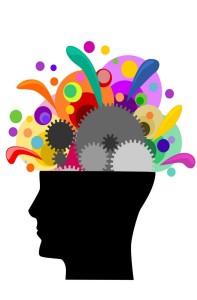A Primer for Letting It Go: When People Get “On Your Last Nerve”
During the course of our daily life, we inevitably push each other’s buttons and pull one another’s triggers. Mostly unintentionally, people can, at times, get “on our last nerve.” We’re human. And most of the time, with the little stuff AND if we’re taking good care of ourselves, it can be easy to just brush it off.

Yet it is also true that when you’ve been hurt (or even annoyed) by someone, at work or in any other part of your life, the path to letting it so is not always so simple. We know that holding on to a grudge or nursing a slight will only make us feel worse- and not just emotionally. Resentments and pent-up irritations can cause our blood pressure to spike and activate stress chemicals that can make us physically sick. And the truth is: it doesn’t really do any good anyway. Any satisfaction in being right or having the last word is short lived and ultimately a misuse of our imagination.
Here are some steps to help you let go when you feel angry, sad or plain indignant:
- Name It-Whether you’ve hurt yourself or have been hurt by another, allow yourself to simply name the feelings that are there. They might include guilt, shame, sorrow, confusion, or anger.
 A study at UCLA found that when you name your emotional experience it turns the volume down on your amygdala, the emotion center of the brain, and brings resources back to your pre-frontal cortex, the rational part of your brain. By naming the feeling, you create some space around it and not become overwhelmed.
A study at UCLA found that when you name your emotional experience it turns the volume down on your amygdala, the emotion center of the brain, and brings resources back to your pre-frontal cortex, the rational part of your brain. By naming the feeling, you create some space around it and not become overwhelmed. - Feel It- Forcing yourself to let go is an oxymoron. Keeping hard feelings bottled up only cause additional stress to your mind and body. Talking it out is helpful- to a point. Sharing helps you expand your perspective, and perhaps even see what happened through a different lens. It’s not about telling everyone your side of a story. It’s about letting out your frustration so you can move on. This could also mean writing about it. The practice below can also help you to pause and sense what you’re feeling.
- Flip Your Focus. If possible, see if you shift your focus from being the victim to seeing the other person as being distracted in their own inner world of worries, who are, like so many of us, stuck in reactivity. People lash out and speak before thinking, sometimes. Have we ever done this? This is difficult to do, but remember, you’re not condoning any action. It’s just about trying to see how each of us are deeply impacted by our life experiences, which informs how we show up in the world.
 Researcher Brene Brown, author of Rising Strong, says, “Blaming is a way to discharge pain and discomfort.” However, it gives us a false sense of control inevitably keeping the negativity kicking around in our minds, increasing our stress and eroding our relationships. Compassion tends to flow a more understanding perspective.
Researcher Brene Brown, author of Rising Strong, says, “Blaming is a way to discharge pain and discomfort.” However, it gives us a false sense of control inevitably keeping the negativity kicking around in our minds, increasing our stress and eroding our relationships. Compassion tends to flow a more understanding perspective.
- Bring Awareness Practices into your daily life. In two recent studies in both the Journal of American College Health and The Journal of Social and Clinical Psychology with several hundred participants that found a direct link that a consistent mindfulness practice supports our ability to forgive.
- Have patience: Forgiving and letting things go isn’t always a one and done. It’s not always a quick fix. It’s a process, so be patient with yourself. With smaller transgressions, forgiveness can happen pretty quickly, but with the larger ones, it can take longer.
A Mini Forgiveness Practice to Try (1x Day):
 Think of someone who has caused you angst (to start, it’s not advisable a person who has deeply hurt you). Visualize the person and even feel the tightness in your unwillingness to let go. Now, observe what emotion is present. Is it anger, resentment, sadness? Use your body as a barometer and notice physically what you feel? Are you tense anywhere, or do you feel heavy? Next, bring awareness to your thoughts; are they spiteful, sad, or something else? If you feel like you have carried this burden long enough, silently repeat: “Breathing in, I acknowledge the hurt. Breathing out, I am forgiving and releasing this burden from my heart and mind.” Continue this process for as long as it feels supportive to you.
Think of someone who has caused you angst (to start, it’s not advisable a person who has deeply hurt you). Visualize the person and even feel the tightness in your unwillingness to let go. Now, observe what emotion is present. Is it anger, resentment, sadness? Use your body as a barometer and notice physically what you feel? Are you tense anywhere, or do you feel heavy? Next, bring awareness to your thoughts; are they spiteful, sad, or something else? If you feel like you have carried this burden long enough, silently repeat: “Breathing in, I acknowledge the hurt. Breathing out, I am forgiving and releasing this burden from my heart and mind.” Continue this process for as long as it feels supportive to you.

 Leading an Authentic Life doesn’t mean spouting your ‘truth’ every time there appears an opening. It’s not the wisest move to be habitually giving your opinions at work or anywhere else for that matter. Yes, honesty matters. And what we are thinking may or may not be the arbiter of truth-ours or anyone else’s. Living with authenticity is different than this. It means to live a life that is genuine and principled.
Leading an Authentic Life doesn’t mean spouting your ‘truth’ every time there appears an opening. It’s not the wisest move to be habitually giving your opinions at work or anywhere else for that matter. Yes, honesty matters. And what we are thinking may or may not be the arbiter of truth-ours or anyone else’s. Living with authenticity is different than this. It means to live a life that is genuine and principled. A large part of living an authentic life involves being aware of your ability to chart your own course, choosing wisely the activities of your day to mirror your intentions and goals. While many things happen each day that we cannot control- we can choose our actions.
A large part of living an authentic life involves being aware of your ability to chart your own course, choosing wisely the activities of your day to mirror your intentions and goals. While many things happen each day that we cannot control- we can choose our actions. Don’t be too deliberate. Without this seeming like a completely contradictory message, consider how you can be intentional in your behaviors without over analyzing and over thinking everything. Too much opinion polling and second guessing in our lives is sometimes called “analysis paralysis.” Deep down, there is an intuitive understanding of who you are as a person. Trust yourself.
Don’t be too deliberate. Without this seeming like a completely contradictory message, consider how you can be intentional in your behaviors without over analyzing and over thinking everything. Too much opinion polling and second guessing in our lives is sometimes called “analysis paralysis.” Deep down, there is an intuitive understanding of who you are as a person. Trust yourself. When you are truly connected to the present moment, there is less attachment to needing certain outcomes or trying to control the way things are. It puts things in perspective and increases connection with the whole of life.
When you are truly connected to the present moment, there is less attachment to needing certain outcomes or trying to control the way things are. It puts things in perspective and increases connection with the whole of life.
 Daniel Goleman’s seminal work, Emotional Intelligence has made universally recognizable the acronyms EI and EQ (referring to Emotional Intelligence and Emotional Quotient). We all seem to have an intuitive grasp of what these terms mean. When referring to a coworker, boss, or a potential employ, we nod our heads approvingly when someone tells us, “She is one of those people with a high EQ” or shake them in sympathy when we hear, “It’s just that he is completely un self-aware, you know, low EQ.” This capacity of individuals to recognize their own, and other people’s emotions, to discriminate between different feelings and label them appropriately, and to use that emotional information to guide thinking and behavior is at the core of leadership competency.
Daniel Goleman’s seminal work, Emotional Intelligence has made universally recognizable the acronyms EI and EQ (referring to Emotional Intelligence and Emotional Quotient). We all seem to have an intuitive grasp of what these terms mean. When referring to a coworker, boss, or a potential employ, we nod our heads approvingly when someone tells us, “She is one of those people with a high EQ” or shake them in sympathy when we hear, “It’s just that he is completely un self-aware, you know, low EQ.” This capacity of individuals to recognize their own, and other people’s emotions, to discriminate between different feelings and label them appropriately, and to use that emotional information to guide thinking and behavior is at the core of leadership competency.  The creator of Google’s Search Inside Yourself program, Chade-Meng Tan, also makes strong the link between EI and mindfulness. Tan wanted to help people find a way to align mindfulness practice with what they wanted to achieve in life, so they can create peace and happiness in themselves, and at the same time create world peace.” This was predicated on the belief that all empathy and kindness come from cultivating a sense of inner calm, which can be achieved through mindfulness. For Tan the key moment came while reading Goleman’s Emotional Intelligence, “I had found my vehicle for aligning meditation with real life, and that vehicle is emotional intelligence. A very good way (and I suspect the only way) to truly develop EI is with contemplative practices starting with Mindfulness Meditation.”
The creator of Google’s Search Inside Yourself program, Chade-Meng Tan, also makes strong the link between EI and mindfulness. Tan wanted to help people find a way to align mindfulness practice with what they wanted to achieve in life, so they can create peace and happiness in themselves, and at the same time create world peace.” This was predicated on the belief that all empathy and kindness come from cultivating a sense of inner calm, which can be achieved through mindfulness. For Tan the key moment came while reading Goleman’s Emotional Intelligence, “I had found my vehicle for aligning meditation with real life, and that vehicle is emotional intelligence. A very good way (and I suspect the only way) to truly develop EI is with contemplative practices starting with Mindfulness Meditation.” And the research is compelling. Research at Harvard and Northeastern have shown that participants in mindfulness training are better able to articulate their emotions and score higher on overall empathy scales than the placebo. Their conclusion: people who regularly practice mindful meditation can more easily develop the ability to detect and understand the emotions of others. And this greater empathy is circular. The continually flowing loop is from self to others back to self. Knowing yourself lies at the core of EQ, and that the best mental app for this can be found in the mind-training method called mindfulness and meditations that strengthen it.
And the research is compelling. Research at Harvard and Northeastern have shown that participants in mindfulness training are better able to articulate their emotions and score higher on overall empathy scales than the placebo. Their conclusion: people who regularly practice mindful meditation can more easily develop the ability to detect and understand the emotions of others. And this greater empathy is circular. The continually flowing loop is from self to others back to self. Knowing yourself lies at the core of EQ, and that the best mental app for this can be found in the mind-training method called mindfulness and meditations that strengthen it.
 “We do not learn from experience…we learn from reflecting on experience.”- John Dewey
“We do not learn from experience…we learn from reflecting on experience.”- John Dewey

 There are lots of ways in which we as human beings can get caught under the vast net of stress in our lives. We oftentimes find ourselves feeling trapped by difficult circumstances and the attending feelings and thoughts that arise from them. All of this can create a sense of being overwhelmed and life at times can appear unmanageable. We then struggle and we suffer. Often times the root cause no longer exists but our coping strategies themselves have become problematic.
There are lots of ways in which we as human beings can get caught under the vast net of stress in our lives. We oftentimes find ourselves feeling trapped by difficult circumstances and the attending feelings and thoughts that arise from them. All of this can create a sense of being overwhelmed and life at times can appear unmanageable. We then struggle and we suffer. Often times the root cause no longer exists but our coping strategies themselves have become problematic. 
